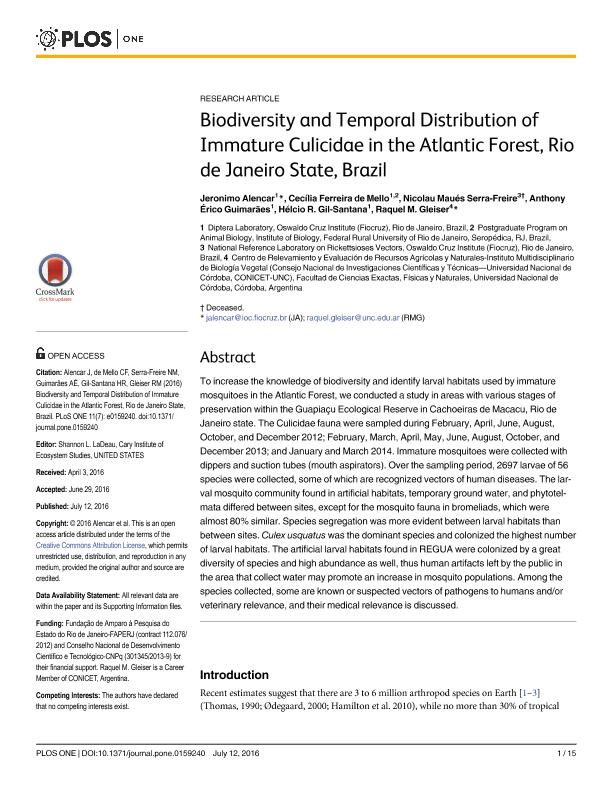Artículo
Biodiversity and temporal distribution of immature culicidae in the Atlantic Forest, Rio de Janeiro State
Alencar, Jeronimo; De Mello, Cecília Ferreira; Serra Freire, Nicolau Maués; Guimarães, Anthony Érico; Gil Santana, Hélcio R.; Gleiser, Raquel M.

Fecha de publicación:
07/2016
Editorial:
Public Library of Science
Revista:
Plos One
ISSN:
1932-6203
Idioma:
Inglés
Tipo de recurso:
Artículo publicado
Clasificación temática:
Resumen
To increase the knowledge of biodiversity and identify larval habitats used by immature mosquitoes in the Atlantic Forest, we conducted a study in areas with various stages of preservation within the Guapiaçu Ecological Reserve in Cachoeiras de Macacu, Rio de Janeiro state. The Culicidae fauna were sampled during February, April, June, August, October, and December 2012; February, March, April, May, June, August, October, and December 2013; and January and March 2014. Immature mosquitoes were collected with dippers and suction tubes (mouth aspirators). Over the sampling period, 2697 larvae of 56 species were collected, some of which are recognized vectors of human diseases. The larval mosquito community found in artificial habitats, temporary ground water, and phytotelmata differed between sites, except for the mosquito fauna in bromeliads, which were almost 80% similar. Species segregation was more evident between larval habitats than between sites. Culex usquatus was the dominant species and colonized the highest number of larval habitats. The artificial larval habitats found in REGUA were colonized by a great diversity of species and high abundance as well, thus human artifacts left by the public in the area that collect water may promote an increase in mosquito populations. Among the species collected, some are known or suspected vectors of pathogens to humans and/or veterinary relevance, and their medical relevance is discussed.
Palabras clave:
BIODIVERSITY
,
LARVAL HABITAT
,
CULICIDAE
,
MOSQUITO
Archivos asociados
Licencia
Identificadores
Colecciones
Articulos(IMBIV)
Articulos de INST.MULTIDISCIPL.DE BIOLOGIA VEGETAL (P)
Articulos de INST.MULTIDISCIPL.DE BIOLOGIA VEGETAL (P)
Citación
Alencar, Jeronimo; De Mello, Cecília Ferreira; Serra Freire, Nicolau Maués; Guimarães, Anthony Érico; Gil Santana, Hélcio R.; et al.; Biodiversity and temporal distribution of immature culicidae in the Atlantic Forest, Rio de Janeiro State; Public Library of Science; Plos One; 11; 7; 7-2016; 1-15
Compartir
Altmétricas



